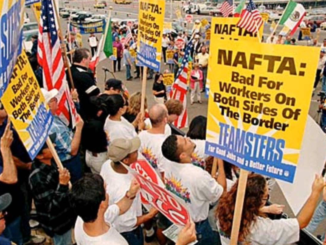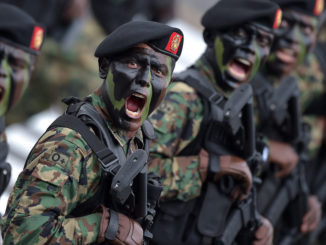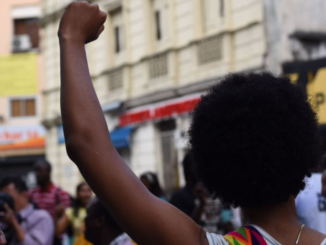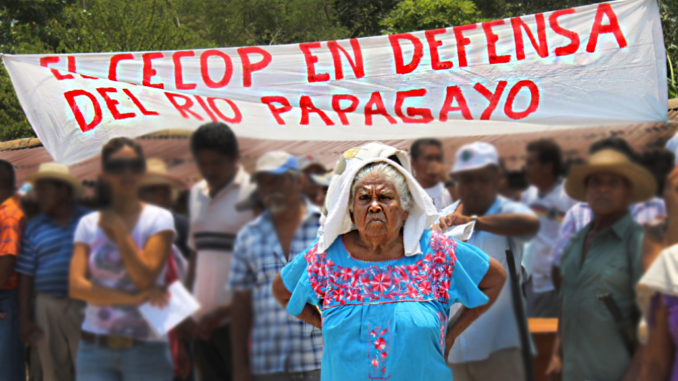
As the Mexican village of La Concepción was still celebrating a local festival, unidentified armed men attacked the local unit of the policía comunitaria or community police in the early hours of Jan. 7. The attack left two community police and six of the armed aggressors dead, and was swiftly followed by a violent state crackdown
La Concepción is part of the communal landholding of Cacahuatepec that is comprised of 47 such villages, located in the district of Acapulco in the southern state of Guerrero, Mexico. The attack targeted members of the community police force known as CRAC-PC (Regional Coordination of Community Authorities – Community Police), along with members of the Council of Ejidos (communal lands) and Communities Opposing the Dam La Parota (CECOP), a local people’s organization that has spearheaded the resistance to a proposed hydroelectric power plant to be built by the Comision Federal de Electricidad (CFE, Federal Commission of Electricity) on the Papagayo River since 2006. The formation of the local unit of CRAC-PC in Cacahuatepec is closely related to growing armed confrontations as a result of the conflict around the dam project. CECOP decided to incorporate Cacahuatepec into CRAC-PC in 2014 as a measure of self-defense.
Following the armed attack, later the same day a large number of state and federal police, as well as members of the army, were mobilized in and around La Concepción. State armed forces spread throughout the surrounding villages and raided the houses of other members of CECOP despite having no official permission or search warrants. State forces launched a second round of violent attacks against the residents of La Concepción, killing another three members of CRAC-PC. Police then arrested two key spokespersons of CECOP, Marco Antonio Suástegi Muñoz and his brother Vicente Suástegi Muñoz, and 30 other members of CRAC-PC.
The CRAC-PC emerged in the state of Guerrero in 1998 as a citizen effort to try and ensure justice and security in a context where organized crime and the state police forces are inextricably linked.
Meanwhile, journalists covering the events were beaten by police and one photographer was forced to hand over the memory card from his camera at gunpoint. It is further worth noting that among the armed aggressors in this most recent case of violence in Cacahuatepec were local dominant figures who eke out a living from the sale of sand mining along the banks of the Papagayo River, a practice that CECOP had clamped down on owing to the damage this has caused to the life of the river.
This attack follows a long history of violence against and repression of the movement against the La Parota dam in Cacahuatepec. The movement, which began in 2006, has seen the murder of anti-dam community members, as well as violent police repression unleashed on residents in order to prevent them from attending public hearings related to the project. While a set of five such public hearings were conducted between the years 2004 and 2005, each of these took place by bypassing mandated procedure, flouting norms set in place to conduct such hearings, and using brute force of state security forces to prevent residents from attending the hearings and presenting their views. An Agrarian Tribunal found the procedures illegal, ruling between 2006 and 2008 to nullify all five hearings on the basis of cases filed and fought by CECOP.
In one incident, on the way to attend one of these fraudulent hearings in the village of Campanaria in August 2005, municipal police who had barricaded the road confronted CECOP spokesperson Marco Antonio Suástegi Muñoz along with other members of CECOP. In the course of a heated exchange, the police pointed a gun at Suástegi Muñoz’s chest to threaten his life, saying, “Indios pendejos, aquí se van a morir” (“Indian assholes, here you are going to die”).
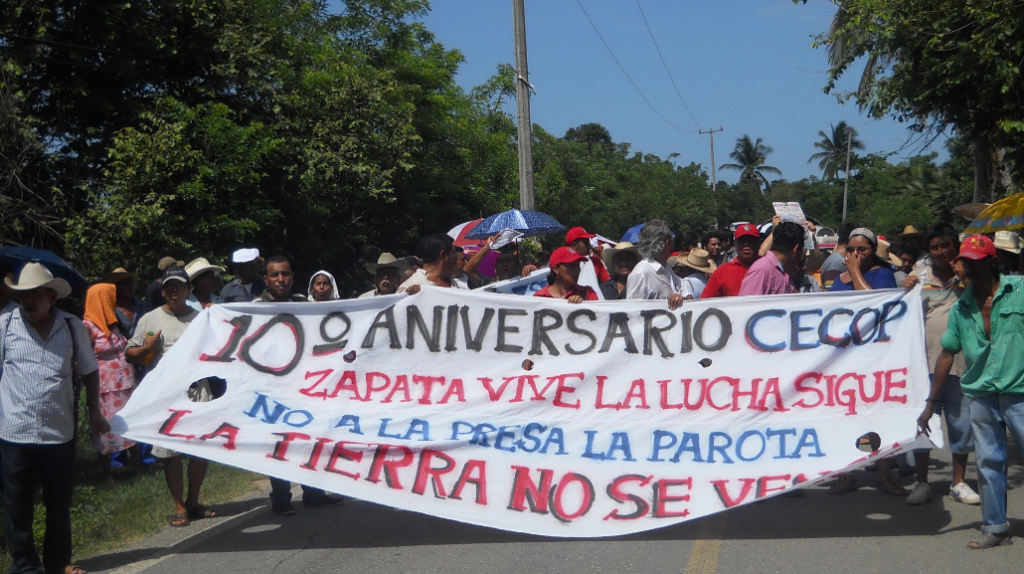
In 2014, Marco Antonio was arrested and kept in jail for 14 months on false charges of homicide. Several organizations in Mexico came together to protest the use of violence against him in jail. Like in 2014, this latest instance of arbitrary arrests and violence ignored and trampled on rights to due process, including the requirement of presenting mandated papers and arrest warrants, ensuring access to lawyers, providing information on detainees’ whereabouts and ensuring access to family members.
The blatant disregard for due process in this latest instance of violence against residents of Cacahuatepec opposing the La Parota dam violates the human rights of those arrested. The National Commission for Human Rights (CNDH) has called on the state government of Guerrero to take measures to protect human rights in the region, and local human rights organization Tlachinollan has called for due process and habeas corpus guarantees for those detained.
Armed confrontation in Cacahuatepec can be traced back to the entry of the army for the first time in 2013 in order to oversee an election of local agrarigan authorities known as comisariado. The position of the comisariado has taken on renewed significance in the context of the conflict over land, particularly the ability to sell or lease land, as the confrontation between pro-dam and anti-dam community members has reached heightened intensity with the introduction of the proposed project. CECOP initiated the formation of a local unit of the CRAC-PC as a form of self-defense following further incursions of the army, harassment of individual CECOP members by the army, as well as threats from armed miscreants, mostly in favor of the proposed hydroelectric power project.
Support independent journalism by becoming a subscriber on Patreon.
The CRAC-PC emerged in the state of Guerrero in 1998 as a citizen effort to try and ensure justice and security in a context where organized crime and the state police forces are inextricably linked. It has maintained a close relationship with voices of the community that have resisted extractive industries, defending the right to their lands and territories, and asserting their right to self-determination in deciding the future course of their communities. Even as the government recognizes CRAC-PC as a legitimate formation in the state of Guerrero, state forces have had a history of constantly attacking, provoking, and confronting the community police, arresting its leaders and destabilizing the organization, whether by undoing its attempts at ensuring security and justice, or by engendering splits and counter formations.
There exists a clear and direct connection between the attempt to bulldoze ahead with the massive hydroelectric power plant on the Papagayo River and the rise in violent confrontations and a constantly tense and volatile atmosphere in Cacahuatepec. The introduction of the project that divided not only communities, but also friends and families, between those in favor of the dam and those opposed to it, has had serious implications on communal relations in this region. State forces have amply exploited, exacerbated, and actively created this division to foment high-intensity violence.
Together, this context lays bare the message being sent to members of CECOP and CRAC-PC — that they will face threats, intimidation, and even assassination for raising their voice against injustice, defending their right to their ancestral lands and territory, and for asserting their right to self-determination in their community’s development and future.
Vasundhara Jairath is an academic based in India who works on issues relating to land, development and dispossession in Latin America and India.

